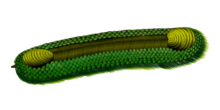| Halkieria Temporal range:
| |
|---|---|

| |
| Halkieria evangelista from the Lower Cambrian Sirius Passet, North Greenland | |

| |
| Life restoration | |
| Scientific classification | |
| Domain: | Eukaryota |
| Kingdom: | Animalia |
| (unranked): | Spiralia |
| Superphylum: | Lophotrochozoa |
| Phylum: | Mollusca |
| Family: | †Halkieriidae Poulsen, 1967 |
| Genus: | †Halkieria Poulsen, 1967 |
| Type species | |
| Halkieria obliqua Poulsen, 1967[1]
| |
| Species | |
| Part of a series on |
| The Cambrian explosion |
|---|
 |
The halkieriids are a group of fossil organisms from the Lower to Middle Cambrian. Their eponymous genus is Halkieria /hælˈkɪəriə/, which has been found on almost every continent in Lower to Mid Cambrian deposits, forming a large component of the small shelly fossil assemblages. The best known species is Halkieria evangelista, from the North Greenland Sirius Passet Lagerstätte, in which complete specimens were collected on an expedition in 1989. The fossils were described by Simon Conway Morris and John Peel in a short paper in 1990 in the journal Nature. Later a more thorough description was undertaken in 1995 in the journal Philosophical Transactions of the Royal Society of London and wider evolutionary implications were posed.
The group is sometimes equated to Sachitida, although as originally envisaged, this group includes the wiwaxiids[2] and is thus equivalent to the Halwaxiida.
- ^ Chr. Poulsen: Fossils from the Lower Cambrian of Bornholm. In: Det Kongelige Danske Videnskabernes Selskab – Matematisk-fysiske Meddelelser, Vol. 36, No. 2, 48 S. + 9 Tafeln, 1967.
- ^ Bengtson, S. (1985). "Redescription of the Lower Cambrian Halkieria obliqua Poulsen". Geologiska Föreningen i Stockholm Förhandlingar. 107 (2): 101–106. doi:10.1080/11035898509452621.